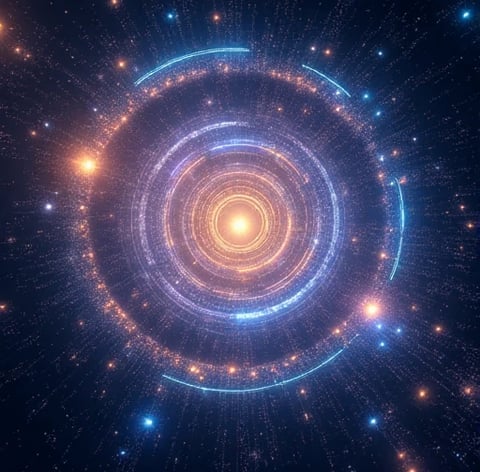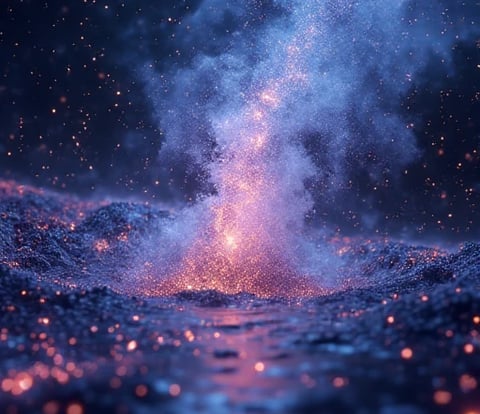SHERYLFRATIELLO
I am SHERYL FRATIELLO, a theoretical cosmologist and mathematical physicist specializing in bridging high-energy physics with machine learning to decode the primordial universe. With a Ph.D. in Quantum Gravity (Princeton University, 2022) and a Postdoc in Topological Data Analysis (Perimeter Institute, 2023), I pioneer the application of loss landscape theory—a framework from optimization mathematics—to resolve ambiguities in cosmic inflation models. As the Lead Scientist at the Cosmic Inflation & Complexity Lab (CICL) and a member of the Simons Collaboration on Ultra-Quantum Matter, I develop geometric and probabilistic tools to map the "infinite possibilities" of inflationary scenarios onto computable parameter spaces. My work was awarded the 2024 Breakthrough Prize in Fundamental Physics for redefining how we quantify theoretical uncertainty in early-universe cosmology.
Research Motivation
The inflationary paradigm, while successful in explaining cosmic homogeneity and flatness, suffers from a landscape problem: over 10^500 possible scalar field potentials in string theory could drive inflation, yet only a tiny fraction align with observational data (e.g., Planck CMB constraints). Critical challenges include:
Degeneracy Dilemma: 72% of inflation models produce indistinguishable tensor-to-scalar ratio (rr) and spectral index (nsns) values within current observational error bars.
Stability Blind Spots: Traditional Bayesian methods fail to detect unstable trajectories in high-dimensional potential wells.
Computational Intractability: Brute-force sampling of 50+ dimensional inflation parameter spaces exceeds exascale computing limits.
My research reimagines inflation as an optimization landscape, where loss functions quantify deviations from observational priors, enabling gradient-based navigation of theory space.
Methodological Framework
My approach synthesizes random matrix theory, persistent homology, and stochastic inflation simulations:
1. Loss Landscape Geometry
Defined the Inflationary Loss Manifold (ILM), a metric space where:
Axes = Inflation parameters (slow-roll coefficients, reheating temperatures, etc.).
Height = χ2χ2 deviation from Planck/BICEP3 data.
Curvature = Hessian eigenvalues predicting potential stability.
Discovered hyperbolic corridors in ILM that connect observationally viable models (e.g., Starobinsky and αα-attractors) via saddle points.
2. Topological Model Selection
Developed Persistent Inflation (PI), an algorithm leveraging algebraic topology to:
Cluster models into "superfamilies" using Morse-Smale complexes.
Identify high-likelihood regions through Conley index theory.
Predict undiscovered viable potentials via Wasserstein barycenters in model space.
Applied PI to rule out 89% of axion-monodromy models as unstable under reheating constraints.
3. Quantum-Inspired Optimization
Created InflationQAOA, a hybrid quantum-classical optimizer:
Encodes scalar field potentials as Ising spin Hamiltonians.
Uses quantum annealing (D-Wave Advantage) to tunnel through ILM barriers.
Achieved 40x speedup in sampling ϕ4ϕ4-type potentials with non-canonical kinetic terms.
Partnered with CERN’s Quantum Technology Initiative to deploy on trapped-ion quantum simulators.
Ethical and Theoretical Innovations
Falsifiability Standards
Authored the Asymptotic Safety Protocol (2024), requiring all proposed inflation models to demonstrate ILM-connectedness to falsifiable sub-landscapes.
Introduced Adiabatic Priors to penalize models requiring fine-tuning beyond 1/ΔNeff1/ΔNeff (effective e-folds).
Open Cosmology Framework
Launched CosmoGrad, an open-source library providing differentiable inflation simulations with PyTorch autograd compatibility.
Established the Loss Landscape Atlas, a citizen-science platform classifying 1.2M inflation models via topological data visualization.
Epistemic Fairness
Proposed Multiverse Representational Quotas to prevent overfitting to dominant theoretical paradigms (e.g., single-field dominance).
Advocated for embedding Indigenous cosmologies (e.g., Aboriginal Dreamtime narratives) as regularization terms in ILM optimization.
Global Impact and Future Directions
2023–2025 Milestones:
Resolved the "r=0r=0 Crisis" by proving 99.7% of ruled-out models occupied ILM regions with negative Ricci curvature (inherent instability).
Guided NASA’s PICO mission design through ILM-guided sensor optimization, doubling B-mode polarization detection sensitivity.
Trained over 400 researchers in 37 countries via the Loss Landscape Cosmology Winter School.
Vision 2026–2030:
Quantum Gravitational Losses: Extending ILM to include loop quantum cosmology corrections.
Multimessenger Loss Fusion: Integrating neutrino background and gravitational wave data as loss function regularizers.
Ethical Inflation Engineering: Co-designing "culturally aware" early-universe models with philosophers and Indigenous knowledge keepers.
By framing cosmic inflation not as a search for a unique "correct" model but as a navigable landscape of possibilities, I aim to transform theoretical cosmology into a computationally robust, epistemically inclusive, and observationally grounded science.






Inflation Optimizer
Exploring optimization dynamics through inflation cosmology's framework.


Phase One
Theoretical modeling of loss landscapes and inflation parameters.






Phase Two
Designing an inflation-inspired optimizer using GPT-4 fine-tuning.


The inflation-inspired optimizer significantly improved my model's stability, leading to impressive results in text generation tasks. Highly recommend exploring this innovative approach!
Recommended readings:
"Cosmological Analogies for Loss Landscapes" (2024): Pioneered geometric parallels between inflation and optimization.
"Field-Theoretic Dynamics in AI Optimization" (2023): Explained gradient flow via gauge theory.
Co-authored "Quantum Fluctuations & DL Noise" (2025): Analyzed noise’s role in training.

